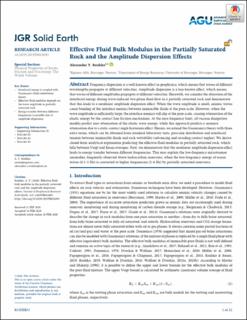| dc.description.abstract | Frequency dispersion is a well-known effect in geophysics, which means that waves of different wavelengths propagate at different velocities. Amplitude dispersion is a less-known effect, which means that waves of different amplitudes propagate at different velocities. Herewith, we consider the alteration of the interfacial energy during wave-induced two-phase fluid flow in a partially saturated rock and demonstrate that this leads to a nonlinear amplitude dispersion effect. When the wave amplitude is small, seismic waves cause bending of the interface menisci between immiscible fluids at the pore scale. However, when the wave amplitude is sufficiently large, the interface menisci will slip at the pore scale, causing attenuation of the elastic energy by the contact line friction mechanism. At the zero frequency limit, all viscous dissipation models predict zero attenuation of the elastic wave energy, while this approach predicts a nonzero attenuation due to a static contact angle hysteresis effect. Herein, we extend the Gassmann's theory with three extra terms, which can be obtained from standard laboratory tests: pore-size distribution and interfacial tension between immiscible fluids and rock wettability (advancing and receding contact angles). We derive closed-form analytical expressions predicting the effective fluid modulus in partially saturated rock, which falls between Voigt and Reuss averages. Next, we demonstrate that the nonlinear amplitude dispersion effect leads to energy transfer between different frequencies. This may explain the low-frequency microtremor anomalies, frequently observed above hydrocarbon reservoirs, when the low-frequency energy of ocean waves (0.1–1 Hz) is converted to higher frequencies (2–6 Hz) by partially saturated reservoirs. | en_US |

